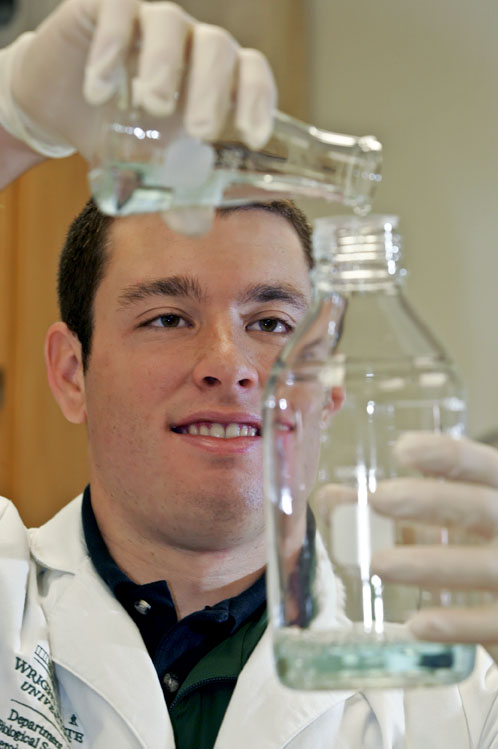Roberta Pohlman still recounts Daniel Hyman’s first visit in a surprised tone.
“He walked into my office a year ago and said, ‘I want to do research.’ He was a freshman,” said Pohlman, Ph.D., associate professor of biological
sciences in Wright State’s College of
Science and Mathematics.
Hyman, of Tucson, Ariz., wasn’t even one of Pohlman’s students. But the freshman honors student and biology major had learned that Pohlman directed the Exercise Biology Program in the Department of Biological Sciences and conducted research in the Boonshoft School of Medicine’s Department of Pharmacology and Toxicology.
He developed a project with Pohlman and Mariana Morris, Ph.D., distinguished professor of research and chair, Department of Pharmacology and Toxicology. Soon, an undergraduate freshman was doing real laboratory research that could lead to new ways to treat human patients.
The project studied how mice that had been fed special diets to make them diabetic got better with regular exercise. Hyman’s work showed that having mice swim as little as one hour per day, three days per week, improved their
diabetic conditions.
He presented a poster on his work in October 2011 at the Ohio Physiological Society’s regional meeting at the University of Cincinnati, and he has submitted another abstract for a national research symposium in Washington, D.C.
Hyman is among the rapidly growing number of undergraduates at colleges and universities who are donning lab coats, according to the National Conference on Undergraduate Research.
Now a sophomore, Hyman has his sights set on an MD degree from Wright State’s Boonshoft School of Medicine. He said he knew the stiff competition for medical school acceptance meant he would have to distinguish himself. Even being in the Honors Program, as he was, would not guarantee it.
“I knew if you’re serious about medical school you’re going to do biomedical research,” he said. In the lab, Hyman found himself setting up experiments, making observations, writing reports, and even training other undergrads who followed him through Pohlman’s door.
“I was surprised at how fast I was incorporated into the research program,” Hyman said. “I thought I was going to be a helper. I didn’t realize how much real research I was going to do.”


 Wright State celebrates Student Success Champions
Wright State celebrates Student Success Champions  Wright State gold team captures 2024 Horizon League team title, Flynn individual champion
Wright State gold team captures 2024 Horizon League team title, Flynn individual champion  118 medical students to graduate from Wright State’s Boonshoft School of Medicine April 28
118 medical students to graduate from Wright State’s Boonshoft School of Medicine April 28  Wright State University continues to demonstrate its financial strength with another credit rating upgrade from Moody’s
Wright State University continues to demonstrate its financial strength with another credit rating upgrade from Moody’s  Thousands celebrate the end of Spring Semester with food, fun and friendship
Thousands celebrate the end of Spring Semester with food, fun and friendship 